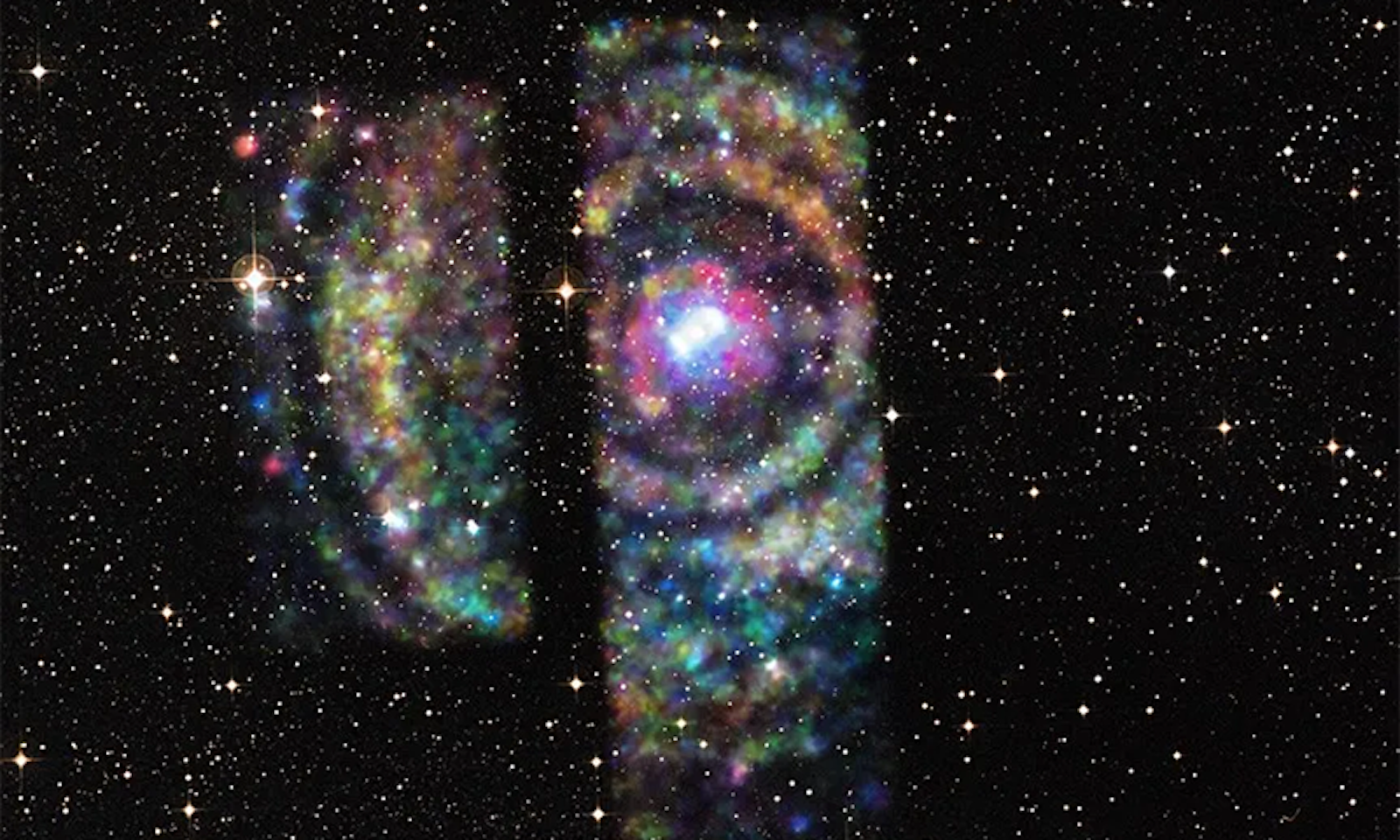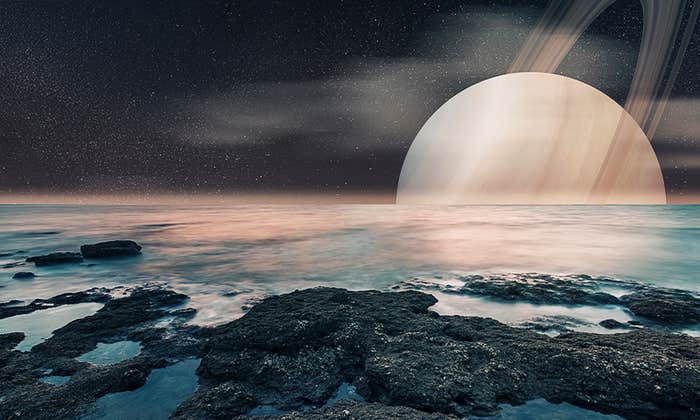Twenty years ago, Andrea Tiengo was a junior scientist watching data stream in from a distant space telescope. He was keeping tabs on routine waves of cosmic X-rays washing over the orbiting, bus-size contraption, relayed to his computer on Earth.
One December afternoon, a peculiar X-ray signal came in. “I saw something like fog, or something blurry, around the point source,” Tiengo says. This one looked different, but it looked so different from any other X-ray observation he had seen that he thought it could be a problem with the hardware. It was getting late in the day, and Tiengo decided to go home and wait to address the problem in the morning. That, he says, “was a big mistake.”
By the next day, the glow was no longer visible to the telescope—and other researchers, instead of him, had made a big discovery. That fog-like signal was the first rings of X-ray “light” from a brilliant gamma-ray burst reflecting off nearby dust. It was an X-ray echo of the blast, an observation no one had ever detected before.
The echoed light arrives minutes to millenia later than the original burst.
Since that missed opportunity, Tiengo, now an astrophysicist at the Scuola Universitaria Superiore IUSS in Pavia, Italy, has spent the past two decades searching for the echoes of other cosmic blasts and interpreting them. Those reflections, it turns out, are gifts akin to a time machine, a way to watch a replay of the bursting, flaring sources. And from that replay, astronomers can decipher details of the original explosion they couldn’t otherwise uncover.
A bit like how bats and other animals use sound bouncing off objects and back to them to understand their surroundings, astronomers can use pings of light energy—not all of which is in the visible range—bouncing off material in the universe. Some types of light, like radio waves, just pass through material instead of scattering off it. But other types, including X-rays and visible light from a star’s explosion—or any changing cosmic light source like a brightening star or a burping black hole—bounce off intervening dust on its way to our eyes and telescopes.
That echoed light ends up taking a longer path to Earth, arriving minutes to millenia later than the original burst’s signal. The length of the delay depends on how much the light roamed and bounced on its way to Earth. And from these second-hand signals, astronomers can begin to reconstruct the stellar blast, rewind the events that led to it, and map the material that lay between it and us.
Although the study of these distant echoes has risen to the fore over the past 20 years, its history extends much further back.
In February 1901, astronomers saw a brilliant “new star,” or nova, in the sky. This star, Nova Persei, had brightened temporarily after an explosion at its surface. This several-day flash of visible light radiated away from the star and bounced around nearby clouds. Later that same year, observers spied a fog around the star—light echoes.
These sorts of events create ideal sources of light echoes for study. And our sky hosts heaps of them. Or has, over the centuries.
In November 1572, it looked like a bright new star had suddenly appeared in the sky. Seen by many and visible to the naked eye, it was described most extensively by Danish astronomer Tycho Brahe—and subsequently dubbed Tycho’s supernova. Some time in the next century, light from another supernova, Cassiopeia A arrived on Earth. The original light flashes from the catastrophic explosions of these once-stars have long-since dissipated, but their echoes are now washing over us. They are the radiating landscapes on which Johns Hopkins University astronomer Armin Rest trains his focus. Through them, he says, “We basically can go back in time.”

Within these echoes, he has found, lie patterns of imprinted information: missing spectral colors that correspond to specific molecules and elements. This is the same pattern as what the original source released, and so seeing an echo later means astronomers can step back and reconstruct the details of the original event. And because oftentimes, they don’t see just one echo but instead see multiple echoes over time, they can watch how the stellar explosion evolved.
With echoes working as sort-of portals to the distant past, Rest and his colleagues have been able to watch a supernova’s blast and paint a picture of how it exploded. We haven’t been able to watch a star explode in real-time, and computer models still struggle to get the details right. So replaying the blast with the delayed echoes lets astronomers peek into the crucial moments.
Even fresh echoes have much to teach us. On Oct. 9, 2022, the brightest gamma-ray burst ever detected showered Earth with its rays. While its original X-ray light blinded most telescopes—making immediate headlines across the globe—the brilliant light energy bounced off nearby dust clouds and gave Tiengo and colleagues echoing rings of that X-ray emission a couple days later. Over the next month, the XMM-Newton satellite he works with captured 20 rings, all surrounding the site of the original blast.
“Each ring,” says Tiengo, “is the vehicle of the same emission” and carries the burst’s imprint. By studying the spectral imprint in these rings, the astronomers reconstructed the details of the original flash: They could see into the past and watch a burst that couldn’t have been observed any other way. From those 20 rings, Tiengo says, they see a hint of something surprising in the explosion, which released more X-rays but with lower energies than expected. Tantalizing clues they and other scientists will continue puzzling over in the quest to better understand how massive stars live—and die.
We see the light from our black hole’s last snack as echoes, hundreds of years later.
Other groups of astronomers are using light echoes to study some of the most mysterious cosmic monsters in the universe. Shuo Zhang of Michigan State University is piecing together the history of outbursts from the supermassive black hole at the center of our galaxy. This behemoth, Sagittarius A*, or Sgr A* for short, today is quiet compared with the tumultuous beasts at the centers of other galaxies. But light reflections off blobs of material at our galaxy’s core imply Sgr A* had a more active and louder past.
Zhang has combined some 20 years of X-ray images from giant clouds of molecular gas, blobs that, she says, “are the perfect recorder to any past outbursts in the galactic center.” Such an outburst follows the black hole snacking on a gas stream, an unlucky star, or some other material that came too close to Sgr A*’s strong gravity. Before being ingested, the snack stretches and swirls around the black hole, spiraling at its outskirts. Those tumultuous movements spew heat and X-rays, which hit the molecules in the nearby giant gas clouds. The light gives some of its energy to the gas in the clouds, making them light up. But some of the X-rays aren’t absorbed and instead bounce off particles in the cloud, like sunlight bouncing off the rippling surface of a lake. That bouncing light’s detour gives it a longer and delayed path to our telescopes. And so, today’s telescopes see the delayed light released during our black hole’s last swirling snack as echoes, hundreds of years later.
The echoes Zhang and her colleagues have tracked over the years, in addition to other X-ray data from different teams, show our galaxy’s central black hole was more active about 200 years ago. The scientists will keep watching as those echoes from the gas clouds continue to evolve over the next several years. They’re looking for the echoes to quiet, which will tell them how long the black hole flared.
Much of the spotting of these echoes is still done the old-fashioned way, by humans pouring over surveys, squinting for the faint fog or rings that large cosmic events leave behind.
But that will change over the next several years. “We are soon ushering in this era of time domain surveys,” says MIT astrophysicist Erin Kara, describing the new approach that will quickly map the sky and reveal minute changes. Kara, who uses light echoes to study the innermost portions of a black hole’s environment, notes that this will be key in finding more radiating echoes in the universe.
Upcoming projects, like the Vera C. Rubin Observatory—scheduled to begin operations in January 2025—and its Legacy Survey of Space and Time will collect scattered light across huge swaths of the sky at once and return to the same view frequently. Complex computer programs will subtract images to look for changes—like brightness variations that could lead to light reflections and foggy light arcs that move from one image to another, indications of echoes. Other future endeavors, such as the China-Europe Einstein Probe, will use a perch above our planet and new technology inspired by lobster eyes to capture an even wider area of the cosmos. With these and others, scientists will step back in time and untangle how these spectacular cosmic events unfolded.
This work takes a broad view. “It’s always better to have more photons than less,” says Tiengo, especially when you’re searching for the faint whispers of flareups from across space—and time. ![]()
Lead image: NASA/CXC/U. Wisconsin/S. Heinz




























